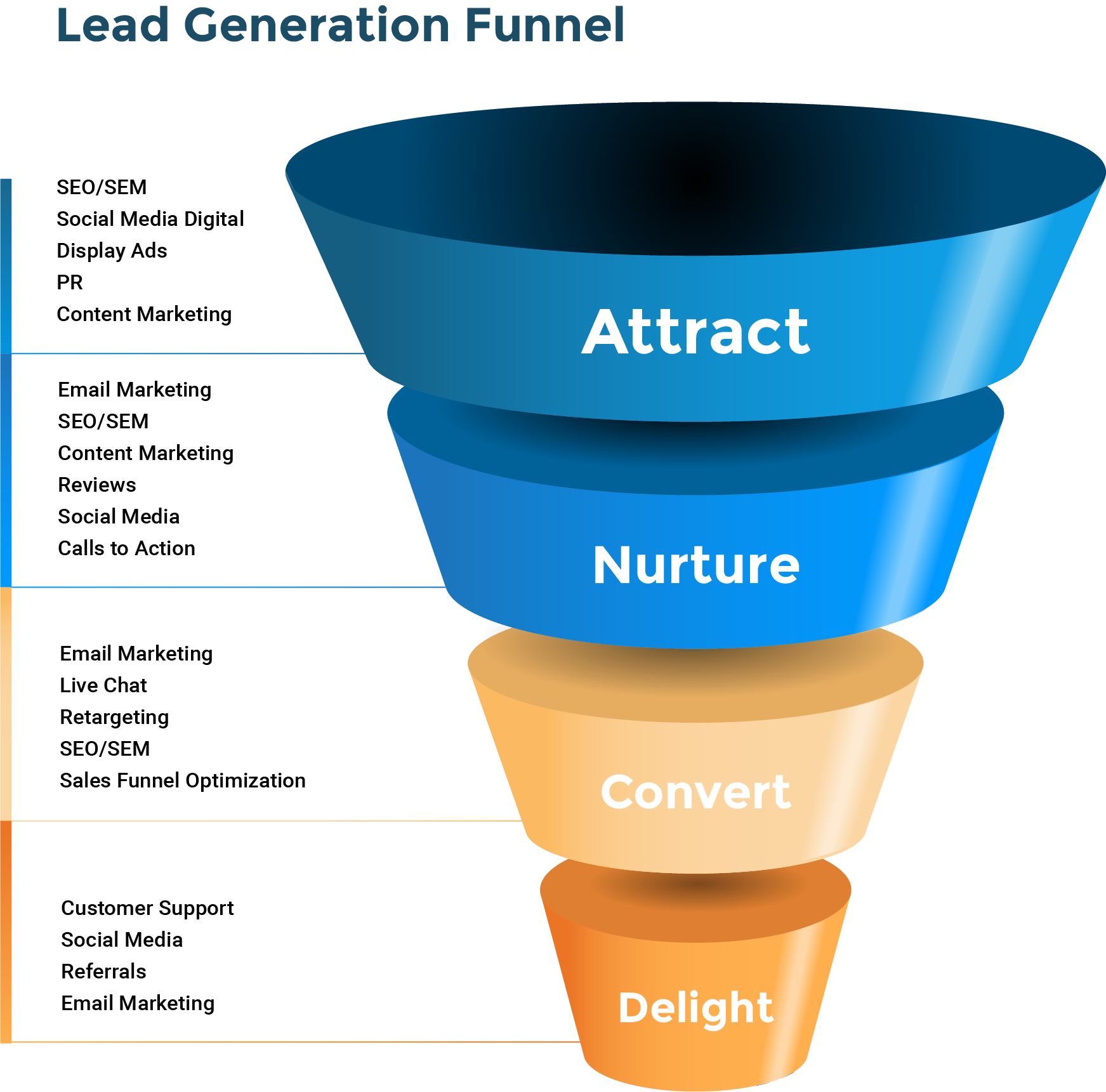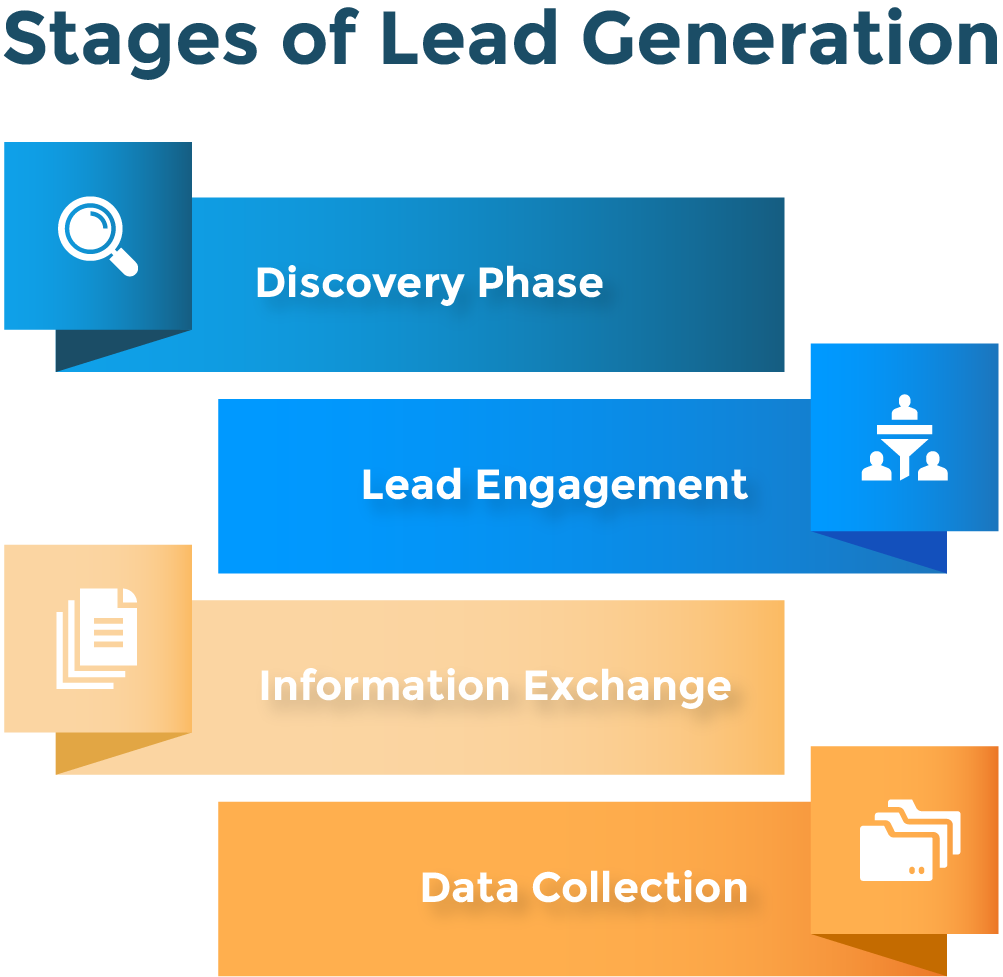One of the most efficient and cost-effective digital marketing methods for attracting new customers is through online lead generation. In this article, we will explain the importance of lead generation and go through the sales lead generation process in more detail to provide you with a better understanding of how you can scale your business using different methods such as search engine optimization, email marketing, landing page and website optimization.
So why is lead generation so important?
Lead generation is a process that allows your brand to gain better visibility among a particular group of individuals that are likely to purchase your product or service. The lead generation process works to educate these individuals on your brands’ competitive advantages, beliefs, and values to establish credibility and trust. Once this credibility is established, you will then have better success when trying to sell your product or service to them. When done correctly, lead generation is a great way to build your business revenue to a new audience of individuals.
What is a lead?
In marketing or sales context, a lead is referred to as a potential customer or prospect. It is important as a business to qualify your leads depending on how they found you online and what particular stage they are at in the selling process. Once a lead is established, they can then be targeted with particular pieces of content or selling language to effectively sell them a product or service. There are a few different types of leads such as:
- Marketing lead – Found your business through some form of online marketing such as social media, search engine optimization, or email marketing
- Product lead – A product lead is someone who found your business online and is now at an education stage, where they begin to learn more about your products and services
- Sales qualified lead – This type of lead has had some sort of interaction with your brand, such as filling out a contact form, clicking on a call to action, or replying to an email, for example
Sales leads should be properly tracked and organized. Many businesses opt to use a CRM system to log a lead’s contact information, keep track of sales messaging, and note their stage of the selling process.
Lead generation benefits
- Allows you to expand selling opportunities to new individuals
- Leads can be monitored and tracked for improved sales performance
- Leads can be profiled with different sales messaging strategies that can often be repurposed
- Lead generation allows businesses to build brand visibility and awareness, even in competitive markets
- Lead generation can often be automated at some stages through CRM platforms
- Effective lead generation can save costs on traditional methods of advertising
Getting started with lead generation
- Consider your current customer and their likes and needs
- Determine which marketing methods and platforms your business has had past success with
- Determine how your product or service fills a particular need or solves a problem to determine competitive advantages
Stages of lead generation
There are a few different stages that a lead will go through within a sales process:
- Discovery Phase – This is when a lead first finds your business. On occasion a lead may have found your brand on their own, this would be known as an inbound lead. Most of the time, a lead discovers your brand through different marketing channels your business may use. This could include search engine optimization, landing page design, or social media posting.
- Lead engagement – Once a lead has found your brand, they are qualified as a lead through some sort of engagement or interaction they have made with you. When visiting your website, they may have clicked on a call-to-action area, showing that they have some level of interest in your product or service.
- Information Exchange – A call to action usually will require a lead to provide some sort of information about themselves, allowing you to further engage in educating and selling them your product or service.
- Data collection and lead interpretation – Once you have some contact information and background about your lead, you can then begin to understand their individual needs. This stage involves collecting information that pertains to your lead, which will then allow you to profile them into different categories to decide which selling strategies will be most effective.
Sales lead generation process
The lead generation sales process requires a high level of attention to detail to attract high-quality leads and use effective selling messaging.

Below, we have described each stage of the lead generation process:
Planning and Research Stage – This is the first stage of the lead generation sales process. This stage begins by first researching your current competitive landscape to determine which types of individuals are likely to purchase your products and services. This is also where you will determine your business’s current competitive advantages over other similar businesses, which can later be used in your selling messaging when targeting new sales leads. The initial research phase also involves profiling your current customers based on different metrics such as age, location, gender, purchasing behavior, and likes and needs. By profiling these individuals, you will then be able to target similar people through your determined lead generation strategy.
Before moving to the next phase of the lead generation process, you will want to determine your selling tools needed. This might involve purchasing a CRM system if you do not have one already to keep track of each lead and their current stage of the sales process. This initial planning phase will also include determination of deadlines for the number of leads you are wishing to target and close each month.
Messaging Phase – Next you will begin planning your sales messaging for your new leads. Sales messaging should be as personalized as possible, and include the lead’s name or other important contact details. You also will want to connect the relevance of your products or services to their current needs and values based on the information you have about them (such as location, occupation, or interests).
Determination of Marketing Channels – Once you have determined who your target audience will be and what types of messaging you will use to sell to them. You will then want to determine which marketing channels you will be using to find new leads. You will want to base your lead generation efforts through previous marketing methods as well as ways your competitors might be finding new leads. There are a variety of different ways to focus your marketing efforts, which might include the following:
- Search engine optimization based on commonly searched keywords by potential leads
- Landing pages designed with your target audience in mind
- Email marketing
- Online blogs posts that serve to educate and entertain potential leads with information that is relevant to them
- Phone calls
Reporting and Analysis – Once you have begun collecting leads through these marketing channels, you will want to ensure you collect information that will help you continue to optimize your lead generation strategy. You may want to consider investing in reporting tools that track how your leads were located, as well as different types of messaging that resulted in a final product or service purchase. This will allow you to continue to improve your lead generation strategy based on which methods were most effective for achieving your sales goals.
How to optimize your lead generation strategy
To best optimize your lead generation strategy, you should consider a few different factors. First, it is important to diversify your lead generation strategy through different types of marketing channels, such as the ones mentioned above. This will provide you with more opportunities to increase sales, as well as allow you to determine which channels are most effective for finding new customers.
Next, always nurture your leads before selling your product or service to them. Nurturing a lead will involve educating them about your business values, competitive advantages, and how your product or service can help fill a need they might have. You can nurture your leads through thoughtful sales messaging and development of educational or informative content on your website (such as an online blog). By properly nurturing your leads, you will establish a higher level of credibility with these individuals, which will likely lead to more sales in the future.
As you nurture your leads, you also will be able to begin profiling them based on selling opportunities. Maybe one lead has filled out your contact form asking specific questions about your product or service. This particular lead would be qualified as a high selling opportunity, and therefore might be further along than a lead that maybe just visited your website once but did not engage any further with specific pages or call to action areas. By profiling your leads, you can determine which type of messaging will be most effective to move them through the sales funnel.
Finally, always evaluate your leads. Maybe you found some leads through one social media channel, but you notice none of them are buying your products or services after moving them through the sales funnel. In this case, you may want to turn to other methods of marketing to find more qualified leads. You will always want to continuously evaluate your leads to ensure you are meeting your sales goals and maximizing your marketing spend in the most effective way possible.
Need Assistance with Your Lead Generation Strategy?
Alliance Interactive is a full service digital agency offering lead generation, website optimization, and digital marketing services. We can help your lead generation strategy through effective marketing campaign management to help drive more traffic and uncover new sales opportunities.
To get started with us, just give us a call at 888-222-9056 or contact us online today!
